Essential Guide to Choosing Windsurfing Gloves
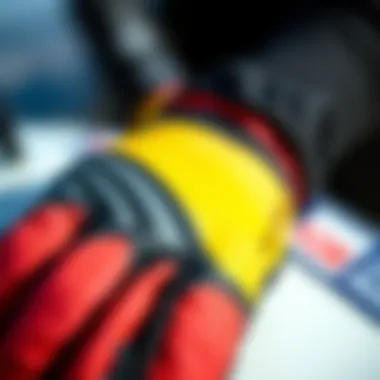
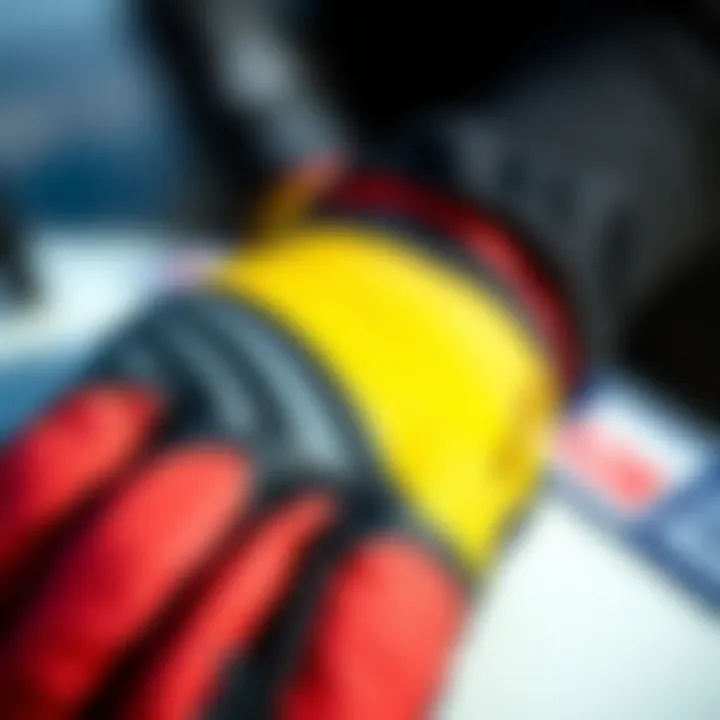
Intro
Windsurfing is not just about riding the waves; it’s about feeling the wind, mastering the balance, and ensuring your safety while you soar above the water. One often-overlooked piece of equipment that plays a pivotal role in this aquatic adventure is windsport gloves. These gloves are not mere accessories; they are essential tools to enhance your grip and protect your hands from the elements, thereby playing a crucial role in both performance and safety.
From the materials used in crafting these gloves to the sizing considerations that can make or break your experience, there's much to unpack. Understanding the various types available—be it neoprene, fingerless, or full-fingered—is equally important as it directly affects comfort and usability. Moreover, many riders are often left in the dust when it comes to maintaining these essential tools, often ignoring how much care they need to retain their functionality.
It’s a common misconception that any pair of gloves will do. However, selecting the right pair according to your unique windsurfing style and environmental factors can be the difference between a seamless sailing experience and an unrelenting struggle. Therefore, this guide is structured to provide you not just with information, but insights into the nuances of selecting and caring for windsport gloves, making it your go-to resource for everything related to your hand gear in the thrilling world of windsurfing.
Understanding the Importance of Windsurfing Gloves
Windsurfing is an exhilarating sport, one that brings thrill and challenge as you harness the power of wind against water. For novices and seasoned windsurfers alike, the equipment and apparel choices can make a notable difference in performance. This is where windsport gloves enter the picture, playing an essential role in enhancing your windsurfing experience. It’s not just a casual accessory, but a necessity that can dictate comfort, safety, and efficiency on the water.
Protection Against Elements
Being out on open water exposes you to various environmental elements. Windsurfing gloves serve as a protective barrier against these forces. Firstly, they keep your hands shielded from harsh weather conditions like biting winds or the relentless sun. A good pair of gloves can prevent sunburn and windburn, protecting the delicate skin on your hands. Furthermore, in cooler conditions, they provide a measure of warmth, minimizing the chill and offering a more enjoyable ride. Imagine gripping your board or sail in frigid temperatures without any coverage—it’s a recipe for discomfort.
Moreover, gloves are also invaluable when it comes to protection against abrasive surfaces. The mast and boom can rub against your hands, especially during harsh maneuvering. A solid pair of gloves acts like armor, preventing blisters and abrasions, allowing you to focus on your performance instead of nursing painful hands.
Enhancement of Grip
Now, consider the mechanics of windsurfing. Maintaining a firm grip on your equipment is paramount. Windsurfing gloves can offer a textured surface that enhances grip, which is especially crucial when maneuvering through intense wind gusts. Slipping can lead to loss of control as your grip loosens, which is something no one wants while navigating at high speeds.
The materials used in glove construction are key. Many gloves feature rubberized palms or silicone patterns that increase friction, making it easier to hold onto the boom without straining your grip. This allows the athlete to exert control and precision movements, improving overall performance. Additionally, for those embarking on freestyling maneuvers, this element of grip can make or break a trick.
Injury Prevention
Injuries are part and parcel of sports, but effective gear can mitigate the risk. Windsurfing gloves can significantly reduce the chances of injury. Proper padding and finger protection help prevent strains and sprains that can occur from the sudden pulls or jerks associated with windsurfing maneuvers. For instance, a well-structured glove can stabilize your hand and wrist, helping to absorb shocks received from swift movements or unexpected pulls from the wind.
Moreover, gloves can aid in preventing repetitive strain injuries, which often develop in athletes who frequently engage in high-repetition motions. Over time, the natural grasping movements that come with windsurfing can place a strain on the hand muscles. Wearing gloves can provide the extra support needed to stave off discomfort and long-term injuries.
Windsurfing gloves are more than just accessories; they are a critical piece of equipment tailored to enhance safety and performance in a demanding sport. Paying attention to their importance can lead to better experiences on the water, enabling every windsurfer to take full advantage of the exhilarating ride that windsurfing provides.
Types of Windsurfing Gloves
When it comes to windsurfing, one size definitely does not fit all. The type of gloves a windsurfer chooses can mean the difference between comfort and blisters, or effective performance versus fumbling with the sail. Each type of glove serves a purpose, tailored to different needs and conditions. Understanding the various options available allows both novices and veterans to make informed decisions that can significantly enhance their experience on the water.
Full-Finger Gloves
Full-finger gloves cover the entire hand, providing maximum protection and warmth. This makes them especially suited for colder weather conditions or longer sessions on the water. The material, often a blend of neoprene and other durable fabrics, ensures that hands stay warm while also offering a good amount of flexibility. With reinforced palms, these gloves help in gripping equipment securely, preventing the dreaded slip that could easily lead to accidents or injuries.
However, these gloves can be a double-edged sword; while they protect, they also may reduce the tactile feedback from the board or sail. If a windsurfer is battling strong winds frequently, a full-finger glove might feel bulky, and the individual might miss out on a more sensitive touch with the gear.
Fingerless Gloves
On the flip side, fingerless gloves offer a unique blend of protection and dexterity. Leaving fingers exposed allows for better tactile control, which can be crucial during maneuvers or when needing to make quick adjustments to the sail. This type of glove is often favored in warmer weather, as it encourages breathability and maintains a cooler feel.
Though fingerless gloves lack the same level of warmth as their full-finger counterparts, they make up for it in versatility. Ideal for those who are transitioning from one maneuver to another or working on tricks, they cater well to a more aggressive windsurfing style. However, it's worth noting that they may not be suitable for everyone, especially in colder waters where even a hint of exposure can lead to a drop in performance due to cold fingers.
Neoprene Gloves
Neoprene gloves are a staple in the windsurfing gear world. This synthetic rubber material is not only waterproof but also highly insulating. Neoprene gloves are encapsulated in a way that creates a barrier against cold winds and water, making them a popular choice for cooler climates. They can range from thin versions that offer comfort in moderate conditions to thicker ones for extreme cold.
The trade-off often lies in the thickness, which can affect freedom of movement. Thicker gloves may provide maximum warmth but can impede hand movement, while thinner varieties boost agility at the cost of some insulation. Wind enthusiasts need to gauge their local climate and choose their neoprene gloves accordingly to strike the right balance between warmth and flexibility.
Thermal Gloves
Finally, thermal gloves are designed specifically for frigid conditions. Made from advanced materials that retain body heat while allowing water to flow away from the skin, these gloves are a lifesaver for those facing winter winds. Their exceptional insulation properties guard against cold and wet conditions, which is essential for enjoying windsurfing without the risk of getting too chilly.
While these gloves can get a bit clunky due to the added insulation layers, they are often fitted with grip-enhancing technologies, maintaining the crucial feel one desires for effective windsurfing. Thus, while thermal gloves may not be the perfect choice for everyone, they come highly recommended for those serious about venturing into the water during colder months.
Material Considerations in Windsurfing Gloves
When it comes to windsurfing gloves, the materials used in their construction can significantly influence performance, comfort, and longevity. Whether you're cruising along a flat lake or navigating turbulent coastal waters, understanding what materials make up your gloves is crucial for making an informed choice.
Neoprene Construction
Neoprene holds its own as a preferred material for many windsurfing gloves. This synthetic rubber is not just flexible but also adept at retaining heat, making it excellent for colder water conditions. The thickness of the neoprene contributes to its insulation properties, yet it offers a snug fit that allows for good dexterity when gripping the rig or the boom. The downside? It can break down under UV light if not properly cared for. To prolong its lifespan, consider rinsing your gloves with fresh water after every session and storing them away from intense sunlight.
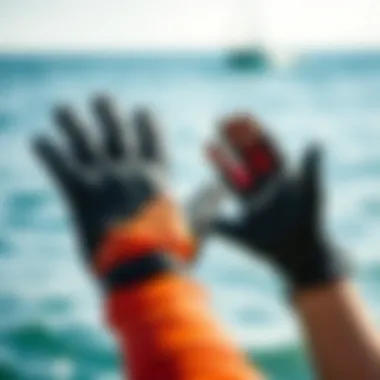
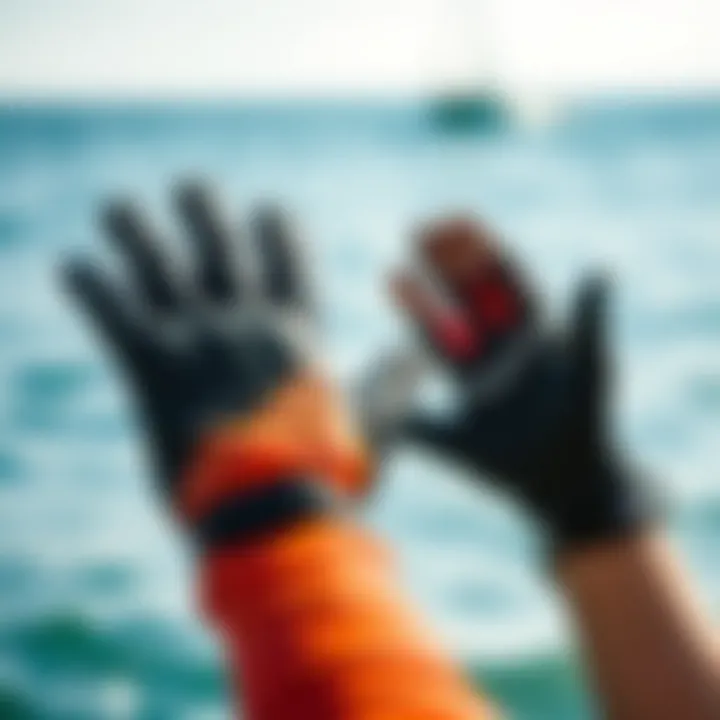
Synthetic Fibers
The use of synthetic fibers, like polyester or nylon, has become common in windsurfing gloves, particularly in the palm and finger areas. These materials are lightweight and quick-drying, providing less bulk than neoprene while maintaining reasonable durability. Synthetic fibers are often combined with added grip technologies, enhancing performance even in wet conditions. Additionally, they can offer breathability, helping to keep your hands from getting clammy during those long runs. However, if you go for synthetic options, keep an eye on wear and tear, as they may not stand up as well to rough treatment.
Leather Varieties
Leather gloves might seem an old-school choice, but they bring undeniable advantages to the table. High-quality leather can offer excellent abrasion resistance and grip control, often sought after by seasoned windsurfers. Furthermore, leather molds to the shape of your hands, offering a personalized fit over time. However, leather lacks the water-resistant benefits found in neoprene, which often leads to heavy soaking and increased drying time. Maintaining leather requires a different level of care, like applying waterproofing agents and regular treatment to keep it supple.
"Choosing the right materials for your windsurfing gloves can make or break your experience on the water."
Understanding the properties of these materials allows for a more informed decision that aligns with your windsurfing style and conditions. Different situations might call for different features, so it's essential to weigh what's most important to you.
Sizing and Fit for Windsurfing Gloves
Getting the right fit for your windsurfing gloves is crucial. A glove that fits well can make all the difference in your overall experience on the water, ensuring comfort, enhanced grip, and protection against the elements. If your gloves are the wrong size, it can negatively impact your performance and enjoyment of the sport.
Measuring Your Hands
To find the perfect fitting gloves, you will first need to measure your hands accurately. It's not as complicated as it sounds. Here’s a simple process to follow:
- Gather Supplies: All you need is a flexible measuring tape and a pen and paper.
- Measure the Width: Place the tape around the widest part of your palm. Make sure it is snug but not too tight.
- Measure the Length: Measure the distance from the tip of your middle finger to the base of your palm. This will show the length of your hand.
- Record the Measurements: Write down both measurements. These will guide you when selecting gloves.
Doing this will help you get a clearer picture of what size will suit your hand best.
Understanding Size Charts
Once you've got your measurements, it’s time to consult the size charts specific to the brand of gloves you’re considering. Sizing can vary widely between manufacturers, so a glance at the chart can save you a lot of hassle later.
- Check for Brand-Specific Sizes: Each brand might have slightly different standards. For example, a medium in one brand may not be the same as a medium in another.
- Consider Additional Features: Some gloves are designed to fit more snugly around the wrist for better support, which may also impact size selection.
Keep in mind that you might want to try a couple of different pairs to get a feel for what fits best.
Common Fit Issues
Finding the right size is essential, but even the best size can lead to problems if the fit isn’t quite right. Here are some common fit issues you may encounter:
Too Tight
A glove that feels too tight might look appealing at first glance, but it can lead to several discomforts. When gloves are snug, they can restrict blood flow to your fingers, leading to numbness or tingling. This not only raises your discomfort level but can affect your dexterity as well, which is crucial for control during windsurfing. It's important to ensure that while they fit snugly, they don't pinch your skin or hinder movement.
- Why Choose Tight Gloves? Some might see tight gloves as a more secure option, thinking they enhance grip and performance. However, when purchased, the discomfort often overcomes the benefits.
Too Loose
On the flip side, loose gloves can be just as problematic. They can lead to poor handling and might slip off during action, leaving you susceptible to scrapes or worse, losing your grip on your equipment. A glove that fits well should move naturally with your hand, feeling as if it's a second skin without getting caught on gear.
- Advantages and Disadvantages: Loose gloves could be seen as comfortable at first, but during vigorous windsurfing activity, their movement can lead to instability and a lack of control.
Finger Length
Lastly, the length of your fingers plays a vital role in selecting gloves. If your fingers are too long for the glove size you choose, it may lead to discomfort and chafing, especially during long sessions on the water. Conversely, if your fingers are too short for the gloves, it can dramatically affect your grip and control.
- Why Is Finger Length Important? Ensuring your fingers fill out the glove without hitting the tip is crucial for maximizing your tactile feedback on equipment. The right length can provide additional comfort and make all the difference in extended windsurfing sessions.
Key Factors to Consider When Buying Windsurfing Gloves
Purchasing the right windsailing gloves is no trivial task. With several options available, it can be a bit like finding a needle in a haystack. However, understanding certain key factors can help streamline your decision-making process. These elements not only influence your comfort but also your performance out on the water.
Weather Conditions
When choosing windsailing gloves, the first thing that springs to mind is the weather. Each season brings its own set of challenges. On hot summer days, you probably want lightweight gloves that promote airflow. Full-finger gloves may lead to sweaty palms and an uncomfortable grip. Conversely, if you're battling chill winds in autumn or winter, thermal gloves with insulated layers become essential.
- In cold conditions, neoprene gloves are a wonderful option. They retain heat and keep your hands agile. However, make sure they are not too bulky, as you still need to feel the equipment intimately.
- On warm days, fingerless gloves could be your best friend, allowing better finger dexterity while still providing some hand protection.
Check out local weather reports or seasonal forecasts if you're unsure about what to expect. This attention to detail can save you from discomfort and perhaps even injury—which no one wants!
Type of Windsurfing
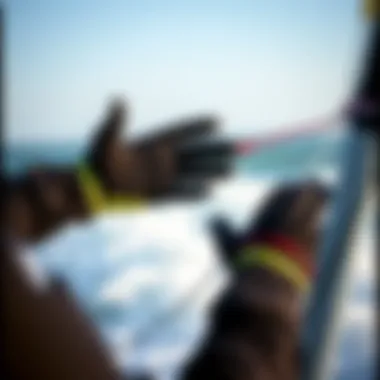
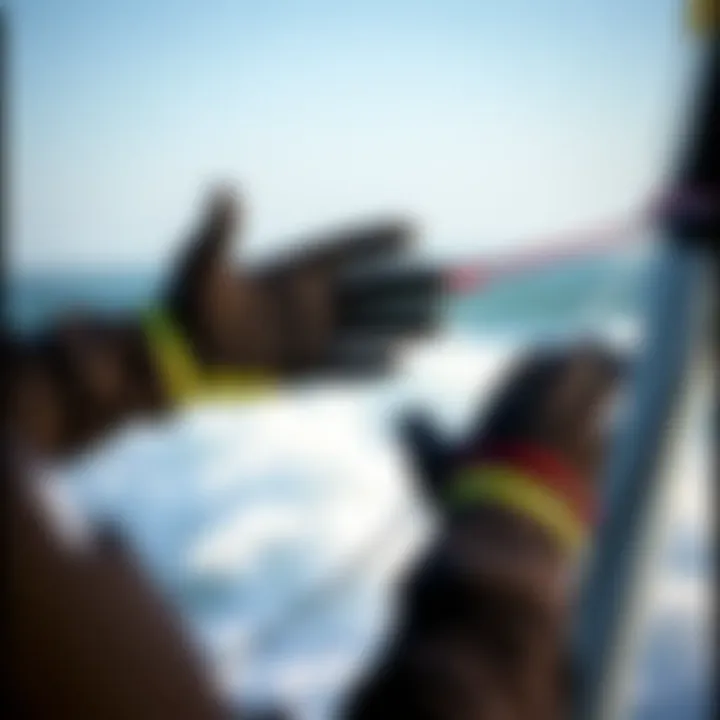
The type of windsurfing plays a pivotal role in what gloves will serve you best. Are you a slalom racer who thrives on speed? Or do you enjoy freestyle sessions where flexibility is crucial?
Different activities demand different glove characteristics:
- Freestyle windsurfing often requires minimal finger coverage for ultimate mobility. Fingerless models or very thin full-finger gloves can enhance your experience.
- If you're into wave riding, you might want gloves designed to withstand tumbling in waves, meaning more robust material may be favorable.
- Freeride riders need something versatile that balances grip, warmth, and dexterity. A standard neoprene glove might meet these needs effectively.
Understanding the demands of your specific windsurfing style will lead you to make choices that elevate your performance.
Budget Constraints
Finally, let’s talk about the elephant in the room: budget. While it’s tempting to go for the most expensive option thinking it’s the best, that’s not always the case. There are plenty of quality gloves out there that don’t break the bank.
- Determine your budget beforehand and stick to it, but having a flexible approach can be beneficial. Sometimes, spending just a little more ensures that you get a glove that not only fits well but also lasts longer.
- Read reviews from other windsurfers who are in the same budget bracket as you. They can provide insights into which gloves deliver value for your money, making it less daunting as you pick between options.
Top Brands in Windsurfing Gloves
When it comes to selecting windsport gloves, the brand you choose can carry significant weight. It reflects both quality and reliability. A well-known brand often signifies a level of trustworthiness and has usually undergone years of research, development, and testing. As every rider's needs differ based on their style and environmental factors, exploring the options offered by established and emerging brands helps tailor your selections to optimize performance and safety on the water.
Established Brands
Some brands have stood the test of time, known for their commitment to excellent craftsmanship and innovative designs. Here are a few household names:
- Dakine: They are revered for their attention to detail and high-quality materials, never compromising on comfort or effectiveness. Their gloves, made of durable neoprene, are widely preferred by experienced windsurfers.
- Mystic: A power player in the windsurfing world, Mystic offers a range of gloves known for their flexibility and insulation properties, ideal for colder climates.
- Prolimit: This brand boasts a focus on functionality, with gloves designed to give superior grip and protection against harsh water conditions. Their models often feature reinforced stitching, which extends the lifespan of the glove.
These established brands often score highly in user reviews, making them worth considering when purchasing.
Emerging Players
While the market is flooded with big names, a few newcomers are sounding the alarm bells with unique features that attract attention:
- ION: Gaining traction for their sustainable practices, ION is quickly becoming notable for producing gloves made from eco-friendly materials without sacrificing performance.
- O’Neill: Often associated with surfing gear, their entry into windsurfing gloves has made waves due to designs that cater specifically to windsurfing needs, combining style and functionality.
- Rip Curl: Known primarily for their surf gear, they are now delving into the windsurfing niche, focusing on innovative water-resistant materials to keep hands dry and agile.
Emerging brands often present new ideas that are not just fashionable but rethink functionality in ways that can redefine user experiences.
Comparative Analysis
In comparing established and emerging brands in the windsport glove market, consider some factors:
- Price: Established brands, while high in quality, may also come with a higher price tag. Emerging brands might provide competitive pricing as they seek to establish themselves.
- Materials Used: Established brands generally offer proven materials, ensuring safety and performance, whereas newcomers may experiment with alternative materials.
- Customization Options: Many emerging companies focus on personalized gear, allowing tailored experiences based on unique needs, which is less common with established names.
"The right glove can make or break a windsurfing experience. It's not just about protection, it's about performance."
When it comes down to it, what fits your hand and meets your windsurfing goals ultimately shapes your experience on the water. Look beyond labels, and find a glove that feels just right.
Maintenance Tips for Windsurfing Gloves
Taking care of your windsurfing gloves is crucial for maintaining their performance and durability. These gloves face harsh conditions—sun, saltwater, and the elements—which can wear them down quickly. Proper maintenance not only prolongs their lifespan but also ensures you stay comfortable while navigating the waters. Like any piece of gear, neglecting this maintenance will lead to necessary replacements sooner than you'd like, so investing a little time in proper care pays dividends down the line.
Cleaning Techniques
Cleaning your gloves after each use is essential, especially if you've been in saltwater or sandy conditions. Here’s how to keep them in top shape:
- Rinse with Fresh Water: After getting out of the water, give your gloves a good rinse with fresh water. Salt and sand can act like abrasive materials and break down the fabric over time.
- Gentle Soap: Use a mild detergent specifically designed for neoprene or sports gear. Apply it gently—avoid scrubbing too hard, as this can damage the material.
- Inside Out: Turn your gloves inside out during cleaning. This ensures that any trapped sweat or dirt can be washed out effectively.
- Thorough Rinse: After soaping up, thoroughly rinse again to ensure no soap residue remains. Soap can break down cleaning products if left too long.
- Avoid Washing Machines: Forget about tossing them in the washing machine—this can cause unnecessary wear and tear that will shorten their lifespan.
By taking these steps, you minimize the risk of damaging the gloves and keep them looking fresh.
Drying and Storage
Proper drying and storage are just as important as cleaning. Wet gloves left in a pile can get musty and lose their shape. Here’s how to dry them properly:
- Air Dry: Lay your gloves flat in a well-ventilated area, out of direct sunlight. Excessive heat can lead to the degradation of materials.
- Avoid Heat Sources: Keep away from heaters or radiators. Neoprene and synthetic fibers don’t react well to forced heat.
- Storage Position: Once dry, store them in a cool, dry place. A mesh bag can be useful for ventilating damp gear, allowing any lingering moisture to escape.
By following these tips, you’ll ensure that your gloves retain their flexibility and comfort without getting warped or cracking.
Signs of Wear
Recognizing when your gloves need replacement is essential for safety and performance. Here are some key signs to look out for:


- Cracking or Peeling: If you notice the material cracking or peeling away, it's a sign that the gloves have reached the end of their tether.
- Thin Spots: Feel for areas that have become noticeably thinner; these spots can easily lead to tears.
- Loss of Grip: If your gloves feel slippery rather than providing a secure grip, it may indicate that the texture has worn down.
- Unpleasant Odor: A lingering, unpleasant smell can also signal that the gloves are harboring bacteria, indicating it’s time to either clean more thoroughly or replace them altogether.
It's wise to address these signs promptly. Delaying replacement not only affects your performance but could potentially lead to accidents on the water.
Taking the time to clean, dry, store, and regularly inspect your windsurfing gloves will help ensure you have gear that supports your adventures rather than hinders them.
User Experiences and Reviews
In the realm of windsurfing, understanding the real-world utility of gloves goes beyond just reading product descriptions or specs. User experiences and reviews provide a window into how these gloves perform under various conditions and how they hold up over time. This section focuses on two key perspectives: feedback from beginners who are just diving into the sport and insights from seasoned professionals.
Beginner Feedback
New windsurfers often have a lot of questions about gear, and gloves are no exception. Beginners usually come with fresh enthusiasm but might not yet grasp the finer details of their equipment. Many novices rave about how the right gloves helped them gain confidence on the water. They find that gloves not only provide protection but also enhance their grip on the boom, which is crucial when learning to balance and manipulate their board.
Beginner feedback tends to highlight a few specific aspects:
- Comfort: Many first-timers report that a well-fitted glove reduces fatigue and ensures they can focus on perfecting their technique rather than being distracted by discomfort.
- Warmth: Those trying the sport in cooler climates particularly appreciate gloves with thermal features. They often mention that warm hands allow them to stay out longer without feeling numbed or chilled.
- Affordability: Beginners often stress the importance of not breaking the bank. They appreciate budget-friendly options that still provide decent functionality, making their entry into windsurfing less daunting.
Ultimately, beginner reviews often serve as reassurance that investing in a pair of gloves can greatly enhance one's ability to learn the ropes of windsurfing. Dipping your toes into this exciting sport becomes a lot easier when you don’t have to worry about frozen fingers or poor grip.
Professional Perspectives
For professional windsurfers, gloves are more than just an accessory; they’re a tool that can significantly affect performance. Experienced riders often have specific preferences shaped by countless hours spent navigating waves and harnessing winds. When they share their experiences, the feedback can get quite nuanced.
Key considerations from professional windsurfers typically include:
- Durability: Professionals expect their gear to withstand rigorous use. They frequently comment on how certain materials or stitching techniques can make or break a glove's longevity. A glove that starts to tear after just a few sessions is swiftly dismissed.
- Flexibility: Flexibility in the glove materials is paramount. Pros often highlight how crucial it is to have unrestricted movement, especially when performing complex maneuvers. Gloves that feel restrictive simply don’t make the cut.
- Performance under Pressure: Lastly, the glove's performance during extreme conditions is a frequent talking point. Professionals may share experiences about how certain brands or models held up during high-wind sessions or challenging waters, helping them maintain control.
"Finding the right gear can mean the difference between an exhilarating ride and a frustrating struggle. It's not just about comfort; it's about performance."
— A seasoned windsurfer on the importance of quality gloves.
Understanding the perspectives from both beginners and professionals enriches the narrative surrounding windsport gloves. It reveals a spectrum of expectations and experiences that cater to a wide range of windsurfing enthusiasts. By gathering insights from various users, one can better appreciate which gloves might suit individual needs, whether it’s for a casual weekend session or a professional competition.
Adaptations for Special Needs
When it comes to windsurfing, not all hands are created equal. In fact, accommodating various hand sizes and specific needs is an essential consideration for maximizing comfort and performance on the water. Whether someone has larger hands that don't easily slip into standard sizes or more petite fingers that can feel lost in the wrong gloves, these adaptations can greatly influence the experience of the sport. The right glove can mean the difference between a day of smooth sailing and a battle with discomfort.
Gloves for Different Hand Sizes
Finding the right glove is no small feat. Not only do you need the right fit for functional reasons, but comfort plays a huge role, too. Here are some considerations:
- Size Variation: Gloves that cater to various hand sizes can enhance grip and control. Having gloves that are too snug or too loose can impede your ability, which is especially crucial when navigating those tricky winds.
- Custom Sizing: Many manufacturers now offer gloves in a range of sizes, including small, medium, large, and even extra-large. A well-fitting glove can provide crucial feedback to the windsurfer’s hands, allowing for precise movements.
- Youth Options: Kids who are just learning the ropes also need gloves designed to fit their smaller hands, helping them to maintain proper grip without compromising their comfort and motivation to continue.
By selecting gloves catered to various hand sizes, you set yourself up for success from the get-go. It’s not just a matter of aesthetics; it’s fundamental to your overall windsurfing experience.
Custom Options
Beyond standard sizing, the growing trend towards custom options in windsurfing gloves reflects the ever-diversifying landscape of water sports. Custom gloves can include:
- Tailored Fit: Some brands are jumping on the personalized bandwagon, allowing users to submit hand measurements to create gloves that fit like a second skin. This level of precision can be a game-changer.
- Material Choice: Customization often extends to materials. For instance, someone may prefer softer materials for more flexibility, or stiffer options for added durability.
- Unique Designs: Riders can opt for unique graphics or colors that express their style, further personalizing their gear. This type of custom option allows windsurfers to create an emotional connection to their gloves, enhancing their overall experience on the water.
Additionally, consider gloves for more specific needs, like added wrist support for those recovering from injuries or gloves equipped with additional padding for those prone to blisters.
"Custom options offer windsurfers a unique opportunity to tailor their gear to both their personal preferences and practical requirements, enhancing both comfort and performance on the water."
Choosing the right glove isn't merely an aesthetic decision; it's about ensuring optimal performance for every individual out on the water. With the adaptation of gloves for various hand sizes and the ability to tailor design, every windsurfer can find their ideal fit. To explore more about hand sizes and custom options, see various resources such as Windsurfing Federation or user reviews on Reddit's windsurfing community.
The Future of Windsurfing Gloves
The winds of change are always blowing, and the future of windsurfing gloves shows promising developments that can cater to both casual enthusiasts and professionals alike. As technology evolves, glove designs are becoming more sophisticated, focusing on enhancing safety, performance, and user comfort. Understanding what lies ahead in this field is crucial for water sports aficionados who want to stay ahead of the curve and enjoy a better windsurfing experience.
Innovative Materials
Today’s consumers are more conscious of the materials used in their gear. It’s not just about durability anymore; it’s about having gloves that can withstand the elements while being as lightweight as a feather. Future innovations will likely focus on materials that repel water while allowing for breathability. For instance, fabrics made from bamboo fibers or recycled plastics might become common. These materials offer not only environmental benefits but also enhance the performance of the gloves.
Moreover, advanced materials like hydrochromic fabrics, which change color when wet, could serve as visual indicators of wear and tear. This feature could alert the user to replace their gloves before they lose their efficiency, enhancing safety. The use of smart textiles could also play a role here. Imagine gloves embedded with sensors that monitor hand temperature or grip pressure, providing real-time feedback. This kind of technology could drastically reduce risks associated with hypothermia or overexertion.
Technological Advancements
The integration of technology doesn’t stop at materials. As we look to the horizon, we can expect significant technological advancements that could redefine what we know about windsurfing gloves. The use of augmented reality (AR) could be one such innovation. Picture this: a glove with a small screen on the back, showing live wind conditions or suggesting optimal moves based on real-time data from your windsurfing boards. This could provide an edge, particularly in competitive settings.
In addition, manufacturers might start exploring robotics in glove design. Imagine gloves that adjust their tightness or padding based on the conditions you’re facing. Such adjustments could help in ensuring a snug fit while providing support where it’s most needed. This potential integration could open up new avenues for accessibility, allowing users with disabilities to participate more easily in windsurfing.
"In the future, the gloves on your hand might just be as intelligent as the board beneath your feet."
Keep sailing forward into innovations that await in the winds ahead!















